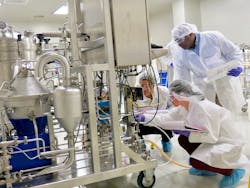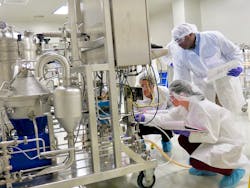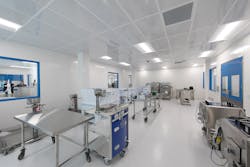The world can’t stop talking about biopharma’s scientific achievements, but the discussion often avoids the industry’s biggest potential buzzkill: a shortage of properly trained workers to manufacture these new drugs.
There’s no denying that biopharma drugs will play a vital role in the future of medicine. Biologics make up about 40 percent of the over 16,000 drugs in the global pharma pipeline. These biologic hopefuls include drugs in new therapeutic areas, such as cell and gene therapy, that are igniting the industry on fire with their potential to treat the previously untreatable. The U.S. Food and Drug Administration estimated that by 2020, they will be receiving more than 200 Investigational New Drug applications for gene and cell therapies per year, and have subsequently hired more clinical reviewers to avoid approval bottlenecks.
As these new classes of therapeutics race towards commercialization, the industry is grappling with the challenges of their highly complex and specific manufacturing processes. For years, biopharma has been scrambling to resolve the production capacity crunch created by cell and gene therapy manufacturing. Contract manufacturers are expanding manufacturing space while drugmakers are building and acquiring their own internal capacity. But facility space is only part of the capacity crisis.
As more new therapies are approved and the industry ramps up facility capacity, biopharma needs to have a properly trained workforce in place.
Traditional training methods are one-dimensional and simply not producing biopharma workers who can “hit the plant floor running.” With help from academia, the biopharma industry is at long last beginning to address this problem and subsequently rethink workforce training — but is this paradigm shift happening fast enough to keep pace with biopharma’s progress?
North Carolina State University
Raleigh, NC
Opened: September 2007; Established as part of a larger grant from North Carolina’s Golden LEAF Foundation to start a statewide public-private partnership now called NCBioImpact.
Objective: To provide educational and training opportunities to develop skilled professionals for the biomanufacturing industry and create the best-trained, most industry-focused workforce possible.
Facility: BTEC operates a 82,500-square-foot main building and a 5,000-square-foot BTEC Annex in the Keystone Science Center.
Academic and professional offerings:
BTEC is part of the university’s College of Engineering. BTEC offers a Master of Biomanufacturing and a Master of Science in Biomanufacturing. The intitute also offers an Upstream Biomanufacturing Graduate Certificate and a Downstream Biomanufacturing Graduate Certificate, as well a minor in Biomanufacturing to undergrad and graduate students. BTEC also offers open-enrollment courses and specialized open enrollment training programs.
What’s cool: At the time it was built, the BTEC building was the only facility of its kind and scale in the U.S., and the largest in the world. The two facilities feature more than $12.5 million-worth of industry-standard equipment and a simulated cGMP pilot plant facility capable of producing biopharmaceutical products using cell growth and expression, recovery and purification processes in a sterile environment.
A slow shift in training efforts
Traditional educational efforts in biopharma look similar to those of conventional pharma. There are ample amounts of colleges and universities offering applicable degrees in areas such as chemistry or biotechnology. Most biopharma companies have developed in-house training programs to get employees on board with standard operating procedures (SOPs). Equipment suppliers will often offer training on their products. In addition, there are numerous organizations offering online training courses as well as virtual training environments.The combination of all of these have been effective, but only to a degree. The efforts share the common goal of giving workers foundational knowledge, centered around compliance.
“The core foundational skills for GMP and aseptic processing haven’t changed much,” asserts John Balchunas, who serves as workforce director for the National Institute for Innovation in Manufacturing Biopharmaceuticals (NIIMBL) in addition to his role as assistant director of professional development programs at the Biomanufacturing Training and Education Center (BTEC). “But that doesn’t mean there isn’t room for improvement, especially when considering recent advances in gene and cell-based therapies.”
BTEC at NC State University is one of a handful of new breed training and educational centers that have stepped up within the last decade to help biopharma tackle its workforce challenges.
In an industry where quality is paramount, a hyper-focus on compliance is both logical and necessary. But it’s become increasingly apparent that training for today’s biopharma workforce needs to go beyond compliance.
Historically, training has been for FDA compliance and simply the need to document that your employees have been trained. "Manufacturers were focused on ensuring that everyone in the company read and understood the SOPs they were responsible for,” says Balchunas. “But lately, within the industry, there’s been a movement towards competency-based training. As the industry evolves, there’s been a push for people at all levels to understand the theory and concepts behind unit operations.”
This need for competency is driving the industry towards more hands-on training — something that has not been the norm — and several academic institutions have stepped up to the challenge.
“We are seeing a transition from traditional education to what the industry truly needs,” says Parviz Shamlou, executive director and head of the Jefferson Institute for Bioprocessing (JIB). “Hands-on training has been missing in the industry’s education system.”
Jefferson University’s JIB, having just opened its facility in May of this year, is the new kid on the training block. It has the unique distinction of being the only specialized education and training institute for biopharmaceutical processing in North America to offer hands-on training entirely on state-of-the-art commercial single-use processing equipment.
It can take biopharma employees up to a year to get the hands-on experience needed to do their job. Any delays in commercial manufacturing — such as those that can occur as companies struggle to train employees or recruit additional workers — mean delays in recouping the estimated $5 billion it can cost to develop a gene therapy.
“Speed to proficiency has been slow in biopharma. It takes companies a lot of time to get workers up to independent performance. Hands-on training is needed to help people to hit the ground running,” says Balchunas.
What’s driving the shift?
Aside from the immediate need for more highly trained workers to manufacture emerging classes of therapeutics, there are several other factors driving this shift in mindset.
Today’s biopharma drugs have pushed the industry towards more flexible and scalable approaches to improving quality and controlling costs. To that end, more companies are gravitating towards single-use technologies, including single-use bioreactors. In situations where treatments need to be created quickly (such as vaccines in an outbreak) or in smaller, more personalized batch sizes (such as CAR-T treatments), single-use equipment can help reduce time spent on cleaning and validation, thus drastically lessening changeover time and associated costs.
One of the challenges of emerging technologies such as single-use systems is that it’s possible that workers enter the field without any prior installation or operating experience. And in the field of biopharma, even the slightest slip-up can mean thousands — if not millions — of dollars in lost product.
“Even something as simple as the installation of a bag needs to be done perfectly because of the value of the contents,” says Shamlou.
JIB’s 25,000-square foot facility is fully equipped with the most advanced single-use technologies on the market, allowing students to get hands-on experience with the same equipment they will likely be seeing on the job. JIB also teaches customized courses for pharma companies looking to get their workers up to speed with single-use.
“Our facility offers a place for people to experiment and learn — and make mistakes,” says Shamlou.
But proficiency in advanced technologies is just one puzzle piece in biopharma’s big picture quest: the need for a more agile workforce.
“As gene and cell therapies come into the fold, they are changing the flow of the typical process development paradigm within biopharma companies,” explains Balchunas. Tech transfer now involves greater process understanding from all parties involved. Those on the R&D side need to understand what’s in the realm of possibility for manufacturing, and those on the manufacturing side need to understand how these new therapies work and how process parameters influence product efficacy.
“There’s a need to break down the silos in order to enable cross training so that folks working in bench-scale research understand manufacturing and vice versa,” says Balchunas.
According to analysis drawn from BioPlan Associates’ annual survey on biopharma capacity, today’s biopharma professionals need to be “broadly knowledgeable and fully capable of independent thinking.” In addition to process understanding, many “soft” skills are needed, such as the ability to communicate and work as a team.
“The industry is looking for a workforce that can adapt — and one way they can adapt is to continuously learn,” says Balchunas.
Stigmas and culture clashes
Workforce woes are not limited to biopharma. Despite recent efforts to revive the manufacturing industry in the U.S., the stigma attached to manufacturing jobs still persists. A recent Deloitte study predicted that over the next decade, nearly 2.4 million manufacturing jobs will be left unfilled due to a skills gap. Most attribute this gap to an incorrect perception of the manufacturing industry as a whole, which is still seen as dirty, dangerous and not technology-based.
Careers in biopharma are typically associated with groundbreaking laboratory research — finding cures for cancers or debilitating diseases like Alzheimer’s — rather than being on the manufacturing floor.
“Manufacturing has long been neglected because research is perceived as more glamorous,” says Shamlou.
Internal struggles are also to blame as the wall between academia and industry is slow to topple. Again, the focus is largely around research. The academic scientist is wary that pharma-sponsored research is market driven and hinders academic freedom, while pharma companies emphasize that risk equates to money and drug discovery projects need to be milestone-driven.
“Many academic institutions are not equipped to move at the rapid pace of the biotech industry. It also is difficult for institutions to create the necessary incentives for faculty to devote significant research and training efforts towards collaborative research within a traditional academic model. This has resulted in a natural segregation between academia and industry leading to the workforce challenges we are experiencing today,” explains Cameron Bardliving, director of lab operations at JIB.
Thomas Jefferson University
Lower Gwynedd, PA
Opened: May 2019; Established in partnership with the internationally recognized National Institute for Bioprocessing Research and Training (NIBRT).
Facility: 25,000-square-foot training facility
Objective: To provide state-of-the-art education and training in the fast-emerging field of biopharmaceutical processing
Academic and professional offerings:
Offers a master’s degree program in engineering with a focus in biopharmaceutical process development and a 12-credit graduate certificate in biopharmaceutical process development, as well as various open enrollment training programs. Specialized courses can be developed to meet industry needs, delivered either at JIB or at the company site.
What’s cool: JIB is the first — and only — specialized education and training institute for biopharmaceutical processing in North America that combines commercial single-use processing equipment with the internationally recognized National Institute for Bioprocessing Research and Training curriculum.
But fortunately, recent years have seen this wall gradually coming down as pharma/academia collaborations (mostly focusing on drug development) are becoming more common. In early 2018, Pfizer created the Innovative Target Exploration Network (ITEN) model designed to identify academic research projects that had the potential to deliver innovative therapeutic targets within Pfizer’s core areas of expertise. The drugmaker named University of Cambridge, University of Oxford and University of Texas Southwestern as the first institutions to participate. Gilead Sciences and Yale University have had a similar arrangement since 2011, when the two forged a multi-year research alliance to accelerate the discovery and development of new drugs to treat cancer.
When it comes to partnering on workforce development, industry organizations such as the National Institute for Innovation in Manufacturing Biopharmaceuticals (NIIMBL), that bring together stakeholders from both sides of the fence, have done a lot to help break down barriers. NIIMBL, a public-private partnership dedicated to advancing biopharma manufacturing, has funded the development of workforce development and training programs fueled by collaborations between academic and industry experts.
But there is still work to be done.
“Pharma companies need to get more engaged and not be afraid to talk to academic institutions about what they are up to and what they need. Similarly, many academic institutions are still learning how to better listen to pharma companies in order to provide the best training. This dialogue will have a huge positive impact on academic institutions and their ability to deliver,” says Balchunas.
Speeding change
But is the gradual paradigm shift towards more hands-on biopharma training going to be enough to sustain this burgeoning industry? For the past 11 years, BioPlan’s biopharma capacity survey has found that “production operations” is the No. 1 area in which biopharma manufacturers plan to hire new staff — indicating an ongoing shortfall in supply of commercial manufacturing-experienced staff.
Dissimilar to many other industries, the pharma/biopharma industry is not credential- or certification-based. Credentials and certifications offer standardized, formal proof of an individual’s qualifications. They have the benefit of indicating that all workers that have attained them have consistent skillsets.
Instead, biopharma is largely experienced-based. “It’s who you know and what you’ve done over your career,” explains Balchunas.
In terms of workers who are new to the field, most biopharma companies have well-established recruiting relationships with the academic institutions providing training, such as BTEC and JIB. But still, these practices are relationship-based rather than relying on formal certifications. Most in the field agree that the biopharma drug pipeline is growing faster than the workforce pipeline, and more drastic action needs to be taken.
But in an industry that is so accustomed to measuring employees by their experience, the idea of certifications and credentials is a big shift. Some past efforts have struggled, including ISPE’s Certified Pharmaceutical Industry Professional (CPIP) credential. ISPE introduced the credential in 2007, revised it in 2011, and officially halted the program in 2013.
While Balchunas says credentialing could be an industry gamer-changer, he also admits it will only come when the industry reaches a point of absolute necessity. “Industry is going to do what makes the most sense. In order for credentialing to be adopted by the industry, it needs to add value over the current state. If companies are able to find the talent they need through current mechanisms, they won’t change.”
Baby steps
Adopting a system of credentialing might be a sprawling change for the industry, but there are steps in between that are more feasible. While not as structured as credentialing or certifications, there has been a push towards more harmonized training efforts. This has come in the form of increased collaboration among academic institutions. In fact, many of the prominent training institutions today have their origins rooted in partnerships with other academic institutions.
“We have not only considered it [collaboration], we have embraced it and are living it,” says Shamlou of JIB. “Our partnership with NIBRT in Ireland and with local community colleges are very good examples of what we are doing towards harmonization.”
JIB partnered with the National Institute for Bioprocessing Research and Training (NIBRT) in Dublin, developing training courses from the internationally recognized NIBRT curriculum. NIBRT, which set a benchmark for quality training when it opened its state-of-the-art bioprocessing facility in 2009, was itself rooted in collaboration. In 2012, the institute won an ISPE Facility of the Year Award (FOYA) in the “Special Recognition for Novel Collaboration” category. The same year, NIBRT won a Bioprocess International Award in the “Manufacturing Collaboration of the Decade” category.
But as more hands-on training institutes pop up in the U.S., it’s natural for them to view each other as competitors and specialized curriculum as proprietary.
“There is a huge need for institutions to look for ways to collaborate more and compete less,” says Balchunas. “This will open the door for more sharing and harmonization down the road. And that’s how the industry takes baby steps towards credentialing and certification.”
Disrupting the status quo
If the biopharma industry grows as projected, it will need a steady supply of well-trained workers ready to manufacture tomorrow’s super drugs. While workforce training has cautiously been progressing as needed, biopharma discovery continues to rocket forward.
The time for change is now or the industry risks stalling the progress of new therapeutic advances.
Overall collaboration within and between industry and academia will help improve the stigma of manufacturing and develop more competency-based, hands-on training programs. Ultimately, the industry may move towards more credential-based training.
These efforts will no doubt pay off, resulting in better trained, more effective workers producing better and more effective treatments.








